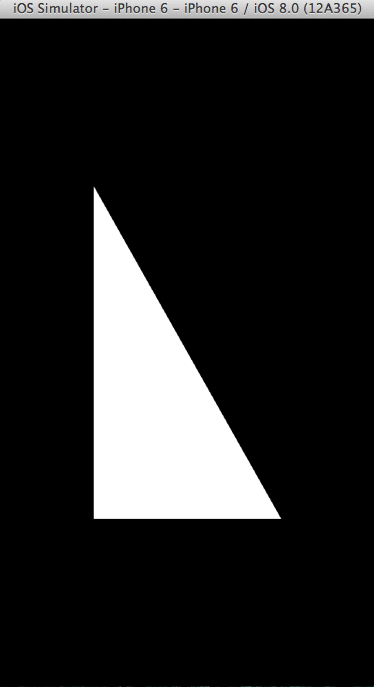所谓顶点缓冲就是直接将顶点数据存储在gpu的一段缓冲区,不需要从cpu拷贝到gpu。提高了程序的运行效率。
操作步骤
1.创建顶点缓冲对象
GLuint vertexBufferID;
2.分配空间
glGenBuffers(1, &vertexBufferID);
3.绑定当前顶点缓冲对象
glBindBuffer(GL_ARRAY_BUFFER, vertexBufferID);
4.初始化缓冲区数据
glBufferData(GL_ARRAY_BUFFER, sizeof(vertices), vertices, GL_STATIC_DRAW);
5.启用顶点属性数组
glEnableVertexAttribArray(GLKVertexAttribPosition);
6.使用顶点数据进行渲染
glVertexAttribPointer( GLKVertexAttribPosition, 3, GL_FLOAT, GL_FALSE, sizeof(SceneVertex), NULL);
7.绘制
glDrawArrays(GL_TRIANGLES, 0,3);
下面赋全部代码
@interface OpenGLESViewController : GLKViewController { GLuint vertexBufferID; } @property (strong, nonatomic) GLKBaseEffect *baseEffect; @end
#import "OpenGLESViewController.h" @implementation OpenGLESViewController @synthesize baseEffect; ///////////////////////////////////////////////////////////////// // This data type is used to store information for each vertex typedef struct { GLKVector3 positionCoords; } SceneVertex; // Define vertex data for a triangle to use in example static const SceneVertex vertices[] = { {{-0.5f, -0.5f, 0.0}}, // lower left corner {{ 0.5f, -0.5f, 0.0}}, // lower right corner {{-0.5f, 0.5f, 0.0}} // upper left corner }; ///////////////////////////////////////////////////////////////// // Called when the view controller's view is loaded // Perform initialization before the view is asked to draw - (void)viewDidLoad { [super viewDidLoad]; // Verify the type of view created automatically by the // Interface Builder storyboard GLKView *view = (GLKView *)self.view; NSAssert([view isKindOfClass:[GLKView class]], @"View controller's view is not a GLKView"); // Create an OpenGL ES 2.0 context and provide it to the // view view.context = [[EAGLContext alloc] initWithAPI:kEAGLRenderingAPIOpenGLES2]; // Make the new context current [EAGLContext setCurrentContext:view.context]; // Create a base effect that provides standard OpenGL ES 2.0 // Shading Language programs and set constants to be used for // all subsequent rendering self.baseEffect = [[GLKBaseEffect alloc] init]; self.baseEffect.useConstantColor = GL_TRUE; self.baseEffect.constantColor = GLKVector4Make( 1.0f, // Red 1.0f, // Green 1.0f, // Blue 1.0f);// Alpha // Set the background color stored in the current context glClearColor(0.0f, 0.0f, 0.0f, 1.0f); // background color // Generate, bind, and initialize contents of a buffer to be // stored in GPU memory glGenBuffers(1, // STEP 1 &vertexBufferID); glBindBuffer(GL_ARRAY_BUFFER, // STEP 2 vertexBufferID); glBufferData( // STEP 3 GL_ARRAY_BUFFER, // Initialize buffer contents sizeof(vertices), // Number of bytes to copy vertices, // Address of bytes to copy GL_STATIC_DRAW); // Hint: cache in GPU memory } ///////////////////////////////////////////////////////////////// // GLKView delegate method: Called by the view controller's view // whenever Cocoa Touch asks the view controller's view to // draw itself. (In this case, render into a frame buffer that // shares memory with a Core Animation Layer) - (void)glkView:(GLKView *)view drawInRect:(CGRect)rect { [self.baseEffect prepareToDraw]; // Clear Frame Buffer (erase previous drawing) glClear(GL_COLOR_BUFFER_BIT); // Enable use of positions from bound vertex buffer glEnableVertexAttribArray( // STEP 4 GLKVertexAttribPosition); glVertexAttribPointer( // STEP 5 GLKVertexAttribPosition, 3, // three components per vertex GL_FLOAT, // data is floating point GL_FALSE, // no fixed point scaling sizeof(SceneVertex), // no gaps in data NULL); // NULL tells GPU to start at // beginning of bound buffer // Draw triangles using the first three vertices in the // currently bound vertex buffer glDrawArrays(GL_TRIANGLES, // STEP 6 0, // Start with first vertex in currently bound buffer 3); // Use three vertices from currently bound buffer } ///////////////////////////////////////////////////////////////// // Called when the view controller's view has been unloaded // Perform clean-up that is possible when you know the view // controller's view won't be asked to draw again soon. - (void)viewDidUnload { [super viewDidUnload]; // Make the view's context current GLKView *view = (GLKView *)self.view; [EAGLContext setCurrentContext:view.context]; // Delete buffers that aren't needed when view is unloaded if (0 != vertexBufferID) { glDeleteBuffers (1, // STEP 7 &vertexBufferID); vertexBufferID = 0; } // Stop using the context created in -viewDidLoad ((GLKView *)self.view).context = nil; [EAGLContext setCurrentContext:nil]; } @end
